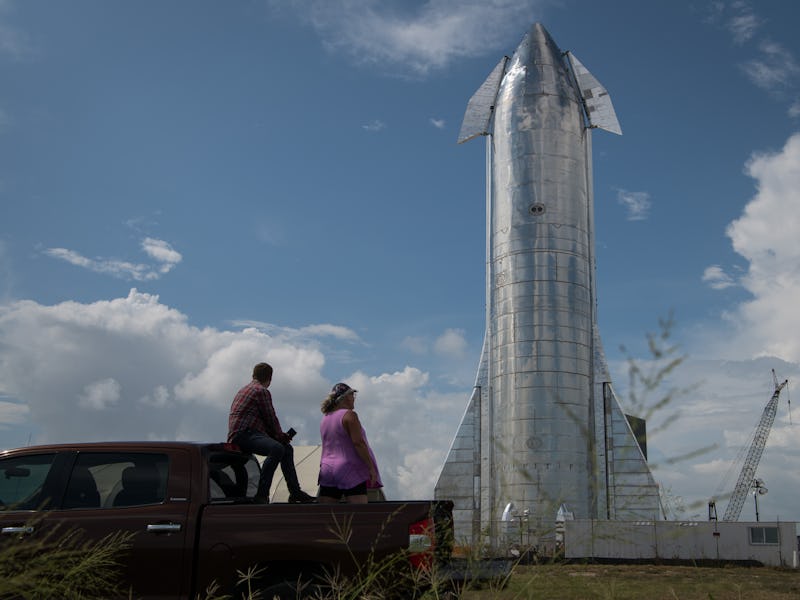SpaceX Starship: Impressive 24-hour timelapse video shows rapid progress
Starbase, the city that never sleeps?

SpaceX is working around the clock to build its rocket to Mars.
Over the weekend, a Reddit user called GetRekta shared a 24-hour timelapse video of SpaceX’s Starbase facility in Texas. The video, first produced by a Twitter account called StarbasePulse, captures the impressive efforts underway to complete the construction of SpaceX’s Starship rocket.
The project is perhaps SpaceX’s most ambitious ongoing plan. The Starship rocket is designed to send over 100 tons or 100 people into space at a time, with a fully-reusable design that CEO Elon Musk hopes will dramatically reduce the costs of spaceflight. Its use of liquid oxygen and methane as a fuel means humans could fly to Mars, refuel using the planet’s resources, and either return home or venture out further.
But first, Starship needs to reach orbit. SpaceX is building a prototype version of the ship itself and the accompanying Super Heavy booster for a short, 90-minute flight from Texas to Hawaii. The ship would land in the water around 60 miles northwest of the coast of Hawaii, while the booster would land 20 miles offshore from the coast of Mexico.
The Federal Aviation Administration is conducting research into these plans to determine whether to issue a license or permit for flights at the Texas facility. Members of the public have until November 1 to submit their comments about the agency’s Programmatic Environmental Assessment draft and SpaceX’s plans.
As SpaceX previously aimed to host the orbital flight sometime this year, it’s perhaps little surprise that teams are working around the clock on the Starship.
Want to find out more about SpaceX’s plans for Starship? Subscribe to MUSK READS+ for exclusive interviews and analysis about spaceflight, electric cars, and more.
SpaceX Starship: How the rocket is taking shape
The video is a captivating peek at a day at SpaceX’s busy facility.
Highlights include:
- The way most of the cranes stop moving for the day around 5 p.m.
- The lights gradually growing brighter as the sun sets around 7:30 p.m.
- The Moon soaring across the sky around 3 a.m.
- The way the Sun gradually rises around 7 a.m.
This 24-hour approach is not new. In an interview with CEO Elon Musk in March 2020, Ars Technica explained how the facility runs. Employees work three 12-hour days and then take a four-day weekend. The following week, they work four 12-hour days with a three-day weekend.
The setup means SpaceX can ideally operate the facility 24 hours a day without overtaxing employees. SpaceX provides hot meals every three to four hours.
The aim is to avoid the crunch period Tesla faced as it tried to produce its Model 3 vehicle at volume. When it first started production in the summer of 2017, it aimed to produce 5,000 Model 3s per week by the end of the year. It eventually reached that goal in the summer of 2018, after a well-documented period of “production hell” where Musk claimed he worked 120-hour weeks.
Despite the FAA’s ongoing process, Musk remained optimistic last month on Twitter that the Starship could still complete its orbital flight this year: “If all goes well, Starship will be ready for its first orbital launch attempt next month, pending regulatory approval.”
It wouldn’t be the first time Musk set an optimistic deadline — in September 2019, when he unveiled the first full-size Starship prototype, Musk claimed SpaceX could host the first orbital flight in a matter of months.
But to meet Musk’s long-term goal of building a city on Mars by 2050, SpaceX may perhaps need to work to optimistic deadlines.
SPACEX STARSHIP ORBITAL FLIGHT: HOW DID WE GET HERE?
- November 2018 — BFR, first announced in September 2017, gets renamed Starship
- December 2018 — Musk confirms the new ship has switched to stainless steel
- January 2019 — Shortened “Starhopper” prototype unveiled, and Musk explains the switch to steel
- February 2019 — Raptor engine beats a long-standing rocket record.
- April 2019 — Starhopper completes a tethered “hop”
- July 2019 — Starhopper launches 20 meters (67 feet)
- August 2019 — Starhopper launches 150 meters (500 feet)
- September 2019 — Starship Mk.1 full-size prototype unveiled
- May 2020 — Starship SN4 full-size prototype completes a static test fire
- August 2020 — SN5 launches 150 meters (500 feet)
- October 2020 — SN8 completes the first triple-Raptor static fire
- December 2020 — SN8 launches 12.5 kilometers (41,000 feet) and crashes into the ground
- February 2021 — SN9 launches 10 kilometers (33,000 feet) and crashes into the ground
- March 2021 — SN10 launches 10 kilometers (33,000 feet), lands, and explodes eight minutes later. That same month, SN11 launches 10 kilometers (33,000 feet) and hits the ground in several pieces.
- May 2021 — SN15 launches 10 kilometers (33,000 feet) and lands without a hitch, except for a small fire at the base
SUBSCRIBE TO MUSK READS+, A PREMIUM NEWSLETTER THAT COVERS THE WORLDS OF ELON MUSK, SPACEX, TESLA, AND EVERYTHING BETWEEN.